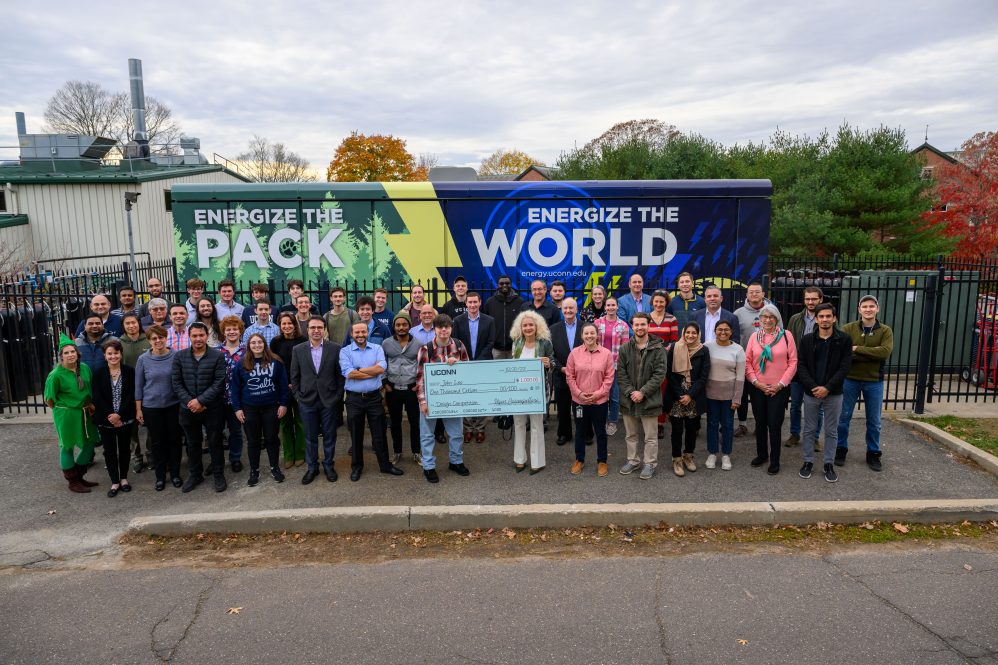UConn’s newly installed fuel cell sports an eye-catching new look, thanks to a student-led design contest aimed at expanding awareness of the clean-energy technology.
The new 460kW fuel cell, recently installed at the Depot Campus in Storrs, was manufactured by HyAxiom, a Doosan company from South Windsor, replacing a 400kW fuel cell. The new fuel cell has a thermal recovery of 1.7 million BTU/hour of useable heat while producing the 460kW of electricity for UConn’s research labs, including those working on advancing fuel cell and microgrid technology at UConn’s Center for Clean Energy Engineering.
UConn’s Clean Energy Society, led by Liam Enea ’24 (CAHNR), facilitated the contest to design a “wrap” for the new fuel cell, which was unveiled in a ceremony at the Depot Campus on Monday, Oct. 31.
“The new fuel cell provides heating and electrical power to the depot campus labs within C2E2,” Enea says. “The former fuel cell had a graphic on the side that read, ‘UConn is putting clean energy to work’ and was used as the backdrop for a lot of energy events.”
In August, U.S. Department of Energy Secretary Jennifer Granholm came to the Depot Campus to learn about UConn’s leadership in clean energy research and application. The new fuel cell is a prelude to more fuel cells that will be popping up around UConn’s campuses over the next few years.
“We ran the contest to get designs to make something that really represents UConn’s innovation and research in that field,” Enea says.
The winner of the wrap competition, John Leo ’26 (ENG), was selected after a board identified the top four contestants based on their design concepts. The top two finalists had the opportunity to refine their design concepts with professional graphic designers in University Communications. All four finalists received a monetary award.
During the first phase of the competition, Leo, who is majoring in computer science, worked independently.
“I built a tree pattern and an electricity pattern out of basic shapes, using simple clipart as a reference,” he says. “I colored them, shaped them into backgrounds, and separated them with an awesome-looking realistic lightning bolt effect. Its color scheme makes it very clear that it’s related to clean energy.”
Once selected as a finalist, Leo partnered with Christine Ballestrini, associate director of branding and visual identity, and lead designer in University Communications. She helped Leo create the final design, which now adorns the fuel cell at the Depot Campus.
“She helped me rework my draft from the ground up,” Leo says. “My original electricity background leaned more towards the warm color spectrum; with her help it was decided to switch it to blue. She helped incorporate the paw print and earth logos from the side panels into the design. Special thanks goes to her for helping me out.”
UConn President Radenka Maric, who met with Granholm at the fuel cell event in August, says all the students involved, from the Clean Energy Society to the contest entrants, should be proud of their work.
“I am very impressed by the talent and creativity of the students who worked on this design project, and I am grateful to the Clean Energy Society for taking the lead on this effort,” Maric says. “Anyone looking at this fuel cell wrap will know that UConn is a place where the arts and sciences don’t merely co-exist, but produce fruitful collaborations. I congratulate the winners of the competition, as well as all the students who created designs for it.”
UConn is committed to a carbon-neutral campus by 2030, and fuel cells are an effective way to help achieve carbon reduction goals.
“Fuel cells are a major step forward in supplying lower emissions, reliable 24/7 baseload power as we are preparing for the Hydrogen Economy,” says Stan Nolan, UConn’s Director of Utility Operations and Energy Management. “UConn has a great strategic vision to further develop this technology through our research and on campus applications. Fuel cells have several advantages over battery technology such as higher power density, lower cycling and maintenance costs, no recharging time concerns, and flexibility for combined heat and power (CHP) configuration which can achieve up to 90% efficiency.”
Leo’s winning design is now on permanent display as the wrap for the fuel cell, located at 44 Weaver Road on the Depot Campus.



